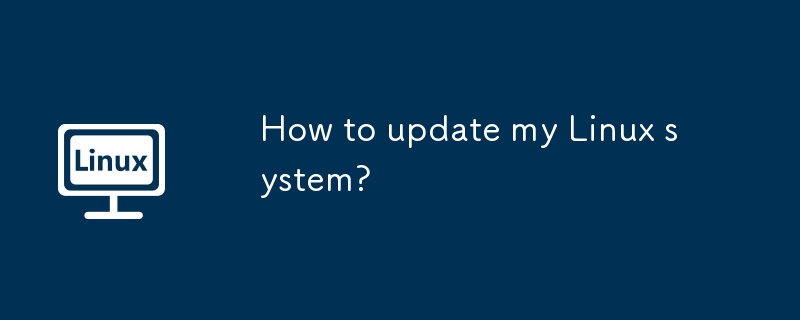
Course Introduction:Arch Linux officially joins the Windows Subsystem for Linux (WSL) family! No external downloads are needed; installation is a breeze using PowerShell: wsl --install archlinux First-time WSL users will need to run this command first, followed by a sy
2025-05-02 comment 0 679

Course Introduction:To view which software packages are installed on the system, you need to use the corresponding commands according to different operating systems. For Ubuntu/Debian systems, you can use dpkg-l to list all installed packages, or extract specific information in combination with awk and grep; you can also use aptlist--installed to view. CentOS/RHEL system can use rpm-qa to view all packages, rpm-q to query individual packages, or use yum/dnflistinstalled. ArchLinux uses pacman-Qqe. Additionally, the package list can be exported to a file for backup or migration, such as dpkg--get-selections>packages
2025-06-13 comment 0 776

Course Introduction:The Linux distribution (distro) is a complete version of the operating system that includes the Linux kernel and various tools, libraries and applications. 1. Its core includes the Linux kernel, 2. Package manager (such as apt, yum), 3. Default desktop environment (such as GNOME, KDE), 4. Pre-installed software and configuration tools. Different distributions are designed for different needs: 1. Novice-friendly models such as Ubuntu and LinuxMint; 2. Stable enterprise models such as Debian and CentOS; 3. Frontier models such as ArchLinux and Fedora; 4. Special models such as KaliLinux and Tails. On update and support mode, 1. Rolling updates (such as Arch) provide the latest features but
2025-07-16 comment 0 109

Course Introduction:Ubuntu is suitable for beginners and users who need stable systems, Fedora is for developers and tech enthusiasts, and ArchLinux provides full control to advanced users. 1. Target users: Ubuntu is suitable for users who need a novice or need an ready-to-use system; Fedora is aimed at developers and technology enthusiasts; Arch is suitable for advanced users who want to learn Linux from the underlying layer. 2. Software update and package management: Ubuntu uses APT, released every 6 months, and LTS supports 5 years; Fedora uses DNF, updates frequently and software is newer; Arch adopts a rolling release mode, uses Pacman, and always provides the latest software, but its stability may be affected. 3. Customization and control: Ubuntu is easier to use but
2025-06-17 comment 0 445

Course Introduction:When updating Linux systems, several key points need to be paid attention to to ensure safety and comprehensiveness. First, use a suitable package manager to update the system, such as Debian/Ubuntu for apt, Fedora/RHEL/CentOSStream for dnf/yum, ArchLinux for pacman, and follow the process of updating the source list first and then upgrading the software package; second, check and update the kernel regularly, especially in manual management or rolling update distributions, and pay special attention to the kernel version, and restart the system after update; third, keep the software source clean and effective, check the source address availability, replace it with a domestic mirror source if necessary and execute the update command; finally, you can optionally enable the automatic update function, such as Ubuntu for installation of u
2025-07-02 comment 0 894

Course Elementary 13770
Course Introduction:Scala Tutorial Scala is a multi-paradigm programming language, designed to integrate various features of object-oriented programming and functional programming.

Course Elementary 82280
Course Introduction:"CSS Online Manual" is the official CSS online reference manual. This CSS online development manual contains various CSS properties, definitions, usage methods, example operations, etc. It is an indispensable online query manual for WEB programming learners and developers! CSS: Cascading Style Sheets (English full name: Cascading Style Sheets) is an application used to express HTML (Standard Universal Markup Language).

Course Elementary 13144
Course Introduction:SVG is a markup language for vector graphics in HTML5. It maintains powerful drawing capabilities and at the same time has a very high-end interface to operate graphics by directly operating Dom nodes. This "SVG Tutorial" is intended to allow students to master the SVG language and some of its corresponding APIs, combined with the knowledge of 2D drawing, so that students can render and control complex graphics on the page.

Course Elementary 24589
Course Introduction:In the "AngularJS Chinese Reference Manual", AngularJS extends HTML with new attributes and expressions. AngularJS can build a single page application (SPAs: Single Page Applications). AngularJS is very easy to learn.

Course Elementary 27446
Course Introduction:Go is a new language, a concurrent, garbage-collected, fast-compiled language. It can compile a large Go program in a few seconds on a single computer. Go provides a model for software construction that makes dependency analysis easier and avoids most C-style include files and library headers. Go is a statically typed language, and its type system has no hierarchy. Therefore users do not need to spend time defining relationships between types, which feels more lightweight than typical object-oriented languages. Go is a completely garbage-collected language and provides basic support for concurrent execution and communication. By its design, Go is intended to provide a method for constructing system software on multi-core machines.
Laravel Modal does not return data
2024-03-29 10:31:31 0 1 591
Can I use the automatic generation module of thinkphp5 in Windows 7 system? How to configure and use
2017-10-10 17:04:14 0 2 1389
2017-10-10 19:25:59 0 4 2943
To use mcrypt_get_key_size() in php study, how to enable mcrypt_
2017-10-10 19:47:34 0 1 1172
Detecting login status and preventing repeated login status in TP5 - My page is wrong
2017-10-10 22:49:15 0 0 1187